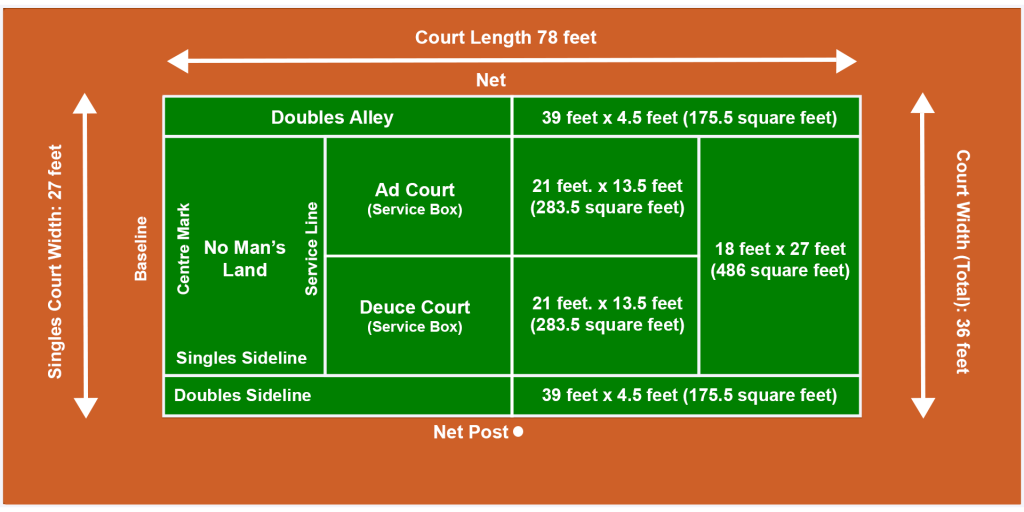Have you ever wondered about the names and significance of those bold markings that adorn a tennis court? Welcome to the tennis court lines guide!
From baseline to service box, alley to sideline, and even the mysterious “tramlines,” these tennis court lines names have their own unique roles and rules in the game of tennis.
Join us as we unravel the mystery behind these markings and delve into their importance in the world of tennis. Let’s ace our knowledge and uncover the secrets of tennis court lines!

Table of Contents
What are the lines on a tennis court?
The tennis court is a canvas of lines, each with its own purpose and significance. Here’s a catchy list-style description of the lines on a tennis court:
- Baseline: The foundation of every point, where players begin their battle, unleashing powerful shots and showcasing their skills.
- Service Box: The launching pad for serves, a strategic zone where players aim to ace their opponents and gain the upper hand.
- Alley: The narrow corridor that tempts players to go for daring shots, offering a tantalizing opportunity to hit winners and widen the playing field.
- Sideline: The boundary that sets the stage for in-bounds and out-of-bounds shots, testing players’ accuracy and precision.
- Center Mark: The focal point of the court, guiding players as they serve, receive, and position themselves strategically during the game.
- Doublesʼ Sideline: The elusive sidelines that add an extra layer of challenge, dictating where players must hit their serves and offering unique angles for strategic shots.
- Service T: The sacred spot where players serve from, a strategic position that can determine the outcome of each point.
These lines are not just paint on the court, but the threads that weave the intricate fabric of the game of tennis, creating a thrilling and dynamic playing field for players to showcase their skills and compete in the ultimate battle of athleticism and strategy.
Baseline
The baseline in tennis is a fundamental and essential part of the court. It refers to the straight line that runs parallel to the net, dividing the court into two halves. The baseline is where the server stands to initiate the point by hitting the ball into the opponent’s court, often using some of the best tennis rackets for control. It serves as the starting point for every rally and is often the launching pad for powerful groundstrokes, such as forehands and backhands. Players must stay behind the baseline while serving and can move along it during the point to engage in strategic play
The baseline is a critical area for players to defend and attack, as shots that land beyond the baseline are considered out of bounds. It is a pivotal zone where players showcase their skills, agility, and court coverage, making it a key component of every tennis match.
Service Box
The service box is a designated rectangular area on a tennis court where the server must aim their serves. There are two service boxes, one on each side of the net, and they are positioned diagonally from each other. The service box is marked by lines, including the singles sideline, center mark, and baseline. It is a critical zone for serving, as the server must land the ball within the boundaries of the service box for the serve to be considered valid.
The size of the service box varies depending on whether it is singles or doubles match. The service box provides an advantage to the server, as a well-placed serve can set up the server for a strong offensive position, putting pressure on the receiver to make a return.
It is a strategic area that requires precision, power, and accuracy to execute effective serves and gain an upper hand in the game.
Alley
The alley in tennis is a narrow corridor that runs parallel to the sideline, located on each side of the court in doubles matches. It is also commonly referred to as the “tramline” due to its resemblance to a tram or train track. The alley is an additional playing area that expands the width of the court for doubles play, providing players with more opportunities for strategic shots. The alley is considered “in-bounds” and serves as an extension of the court, allowing players to hit shots that would otherwise be considered out if they were to land beyond the sideline.
The alley presents players with unique angles for shots, such as cross-court volleys and serves, and challenges them to exhibit accuracy and placement in their play. It adds an extra layer of excitement and strategy to doubles matches, requiring players to utilize the full width of the court to outmaneuver their opponents and gain an advantage.
Sideline
The sideline in tennis is one of the fundamental boundaries of the court, running parallel to the net on both sides. It marks the lateral boundaries of the playing area and serves as a critical reference point for determining whether a ball is in or out of bounds.
The sideline is an essential element in the game of tennis, as shots that land beyond the sideline are considered out and result in a lost point.
Players must demonstrate accuracy and precision in their shots to keep the ball within the sideline, while also strategically aiming for the opponent’s sideline to create challenging returns. The sideline serves as a key parameter in the court, guiding players in shot placement, court coverage, and tactical play.
It is a critical boundary that players must respect and utilize to their advantage in the pursuit of victory on the tennis court.
Center Mark
The center mark in tennis is a small line or mark located at the middle of the baseline, dividing it into two equal halves. It serves as a reference point and a strategic guide for players during the game. The center mark is a critical element in the positioning of players, particularly during serves and returns.
It helps players to align their serves along the center of the court, also known as the “service T,” which is a strategic spot for maximizing serve effectiveness.
The center mark also assists players in positioning themselves strategically during rallies, helping them to maintain a balanced court coverage and control the flow of the game.
It is a key reference point that players rely on to optimize their serves, returns, and overall court positioning, making it an important feature of every tennis court.
Doubles’ sideline
The “Doubles’ sideline” in tennis is the boundary line that marks the outermost edge of the court in a doubles match. It runs parallel to the net on each side of the court and is located farther from the center of the court compared to the singles sideline. The doubles’ sideline is used as the outer boundary for doubles play, where the ball must land within the lines to be considered “in.”
It is marked by a solid line and serves as the limit for shots hit by players during doubles matches. Shots that land beyond the doubles’ sideline are considered out of bounds, resulting in a point for the opposing team. The doubles’ sideline is an important reference point for players, including those new to the sport using the best tennis racquets for beginners, in positioning themselves during doubles play and is a critical element in determining the legality of shots during a match.
Service T
The “Service T” in tennis is a strategic area located at the center of the court, marked by the intersection of the center mark and the service boxes. It is often referred to as the “T” due to its shape, resembling the letter “T” when viewed from above.
The Service T is a critical spot for serving, as it allows the server to target both the left and right service boxes with equal accessibility.
Serving from the Service T provides the server with an advantageous position to strategically place powerful and accurate serves, making it a key element in a player’s serving strategy.
It allows for a wider range of serving angles and options, putting pressure on the receiver and setting the tone for the point. The Service T is a strategic focal point for servers to maximize their serving effectiveness and gain an upper hand in the game.
You can also see our review of the Best tennis shoes for achilles tendonitis here
FAQ About Tennis Court Lines
Are lines considered “inside” in tennis?
Yes, lines are considered “inside” in tennis. If a ball lands on any part of a boundary line, it is considered in bounds and is considered a valid shot. This means that shots that land on the lines are considered in and play continues accordingly, as per the rules of tennis.
How wide are the lines on a tennis court?
The lines on a tennis court are typically 2 inches (5.08 centimeters) wide. They are painted lines that mark the boundaries of the playing area, including the baselines, sidelines, service boxes, and center mark. The lines are an integral part of the tennis court markings and are used to determine whether a ball is in or out of bounds during play. The width of the lines is standardized according to the rules and regulations of tennis to ensure consistency and fairness in the game.
How much space do you need for a tennis court?
The standard dimensions for a tennis court require a minimum space of 60 feet (18.29 meters) in width and 120 feet (36.58 meters) in length. This includes the playing area, which is 78 feet (23.77 meters) in length and 36 feet (10.97 meters) in width for singles play, with additional space for the surrounding areas, such as the baselines, sidelines, and buffer zones. It is important to follow the official dimensions to ensure proper play and adherence to tennis rules and regulations.

I’m Heorhii Rysak, a go-to sports enthusiast and blogger. My fascination with sports began in my childhood with karate, setting the foundation for my love of physical fitness. Over the years, I’ve delved into various disciplines, including martial arts and CrossFit, and developed a passion for tennis. I bring a wealth of practical experience to my blog, where I share equipment reviews, workout plans, and fitness advice. My goal is simple: to inspire and assist you in your journey toward better health and performance.